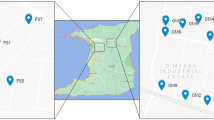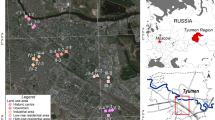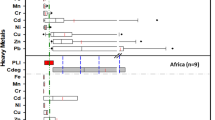Abstract
Contamination status of 942 organic micro-pollutants was examined for settled dust samples collected from an informal end-of-life vehicle (ELV) recycling site and an urban area in northern Vietnam. One hundred and ninety-five contaminants including 73 domestic chemicals, 79 industrial chemicals and 43 pesticides were detected at least once in our samples. Total concentrations (median and range) of organic pollutants in dusts from ELV site and Hanoi urban area were 20,000 (5600–93,000) and 21,000 (12,000–26,000) ng g−1, respectively. Pyrethroid insecticides, polycyclic aromatic hydrocarbons (PAHs) and plasticizers were the major contributors to the overall contamination levels. Concentrations of some specific chemical classes such as petroleum alkanes, PAHs, heat storage and transfer agents, and compounds leached from tires in dusts from the recycling area were significantly higher than those from the urban area, suggesting their emission during ELV dismantling and stockpiling processes. Human exposures to selected organic pollutants were also estimated by calculating daily intake doses to evaluate their hazard quotients (HQs). Although almost HQs were markedly lower than the critical value of 1, potential health risk caused by multiple organic contaminants via dust ingestion and other exposure pathways should be considered in future studies.


Similar content being viewed by others
References
Anh HQ, Nam VD, Tri TM, Ha NM, Ngoc NT, Mai PTN, Anh DH, Minh NH, Tuan NA, Minh TB (2017) Polybrominated diphenyl ethers in plastic products, indoor dust, sediment and fish from informal e-waste recycling sites in Vietnam: a comprehensive assessment of contamination, accumulation pattern, emissions, and human exposure. Environ Geochem Health 39:935–954
Takahashi S, Tue NM, Takayanagi C, Tuyen LH, Suzuki G, Matsukami H, Viet PH, Kunisue T, Tanabe S (2017) PCBs, PBDEs and dioxin-related compounds in floor dust from an informal end-of-life vehicle recycling site in northern Vietnam: contamination levels and implications for human exposure. J Mater Cycles Waste Manag 19:1333–1341
Tue NM, Suzuki G, Takahashi S, Isobe T, Trang PTK, Viet PH, Tanabe S (2010) Evaluation of dioxin-like activities in settled house dust from Vietnamese e-waste recycling sites: relevance of polychlorinated/brominated dibenzo-p-dioxin/furans and dioxin-like PCBs. Environ Sci Technol 44:9195–9200
Tue NM, Takahashi S, Suzuki G, Isobe T, Viet PH, Kobara Y, Seike N, Zhang G, Sudaryanto A, Tanabe S (2013) Contamination of indoor dust and air by polychlorinated biphenyls and brominated flame retardants and relevance of non-dietary exposure in Vietnamese informal e-waste recycling sites. Environ Int 51:160–167
Tri TM, Abualnaja KO, Asimakopoulos AG, Covaci A, Gevao B, Johnson-Restrepo B, Kumosani TA, Malarvannan G, Minh TB, Moon HB, Nakata H, Sinha RK, Kannan K (2015) A survey of cyclic and linear siloxanes in indoor dust and their implications for human exposures in twelve countries. Environ Int 78:39–44
Tri TM, Minh TB, Kumosani TA, Kannan K (2016) Occurrence of phthalate diesters (phthalates), p-hydroxybenzoic acid esters (parabens), bisphenol A diglycidyl ether (BADGE) and their derivatives in indoor dust from Vietnam: implications for exposure. Chemosphere 144:1553–1559
Wang W, Abualnaja KO, Asimakopoulos AG, Covaci A, Gevao B, Johnson-Restrepo B, Kumosani TA, Malarvannan G, Minh TB, Moon HB, Nakata H, Sinha RK, Kannan K (2015) A comparative assessment of human exposure to tetrabromobisphenol A and eight bisphenols including bisphenol A via indoor dust ingestion in twelve countries. Environ Int 83:183–191
Wang W, Asimakopoulos AG, Abualnaja KO, Covaci A, Gevao B, Johnson-Restrepo B, Kumosani TA, Malarvannan G, Minh TB, Moon HB, Nakata H, Sinha RK, Kannan K (2015) Synthetic phenolic antioxidants and their metabolites in indoor dust from homes and microenvironments. Environ Sci Technol 50:428–434
Kadokami K, Tanada K, Taneda K, Nakagawa K (2005) Novel gas chromatography-mass spectrometry database for automatic identification and quantification of micropollutants. J Chromatogr A 1089:219–226
Ha TT, Marcussen H, Hansen HCB, Giang TL, Hanh TD, Nguyen TT, Trung QN, Hansen S, Strobel BW (2017) Screening of inorganic and organic contaminants in floodwater in paddy fields of Hue and Thanh Hoa in Vietnam. Environ Sci Pollut Res 24:7348–7358
Hanh TD, Kadokami K, Pan S, Matsuura N, Trung NQ (2014) Screening and analysis of 940 organic micro-pollutants in river sediments in Vietnam using an automated identification and quantification database system for GC–MS. Chemosphere 107:462–472
Hanh TD, Kadokami K, Hong TCC, Trung QN, Thao TN, Kong L (2015) Groundwater screening for 940 organic micro-pollutants in Hanoi and Ho Chi Minh City, Vietnam. Environ Sci Pollut Res 22:19835–19847
Kadokami K, Pan S, Hanh DT, Li X, Miyazaki T (2012) Development of a Comprehensive analytical method for semi-volatile organic compounds in sediments by using an automated identification and quantification system with a GC–MS database. Anal Sci 28:1183–1189
Kadokami K, Jinya D, Iwamura T (2009) Survey on 882 organic micro-pollutants in rivers throughout Japan by automated identification and quantification system with a gas chromatography–mass spectrometry database. J Environ Chem 19(3):351–360
Kadokami K, Li X, Pan S, Ueda N, Hamada K, Jinya D, Iwamura T (2013) Screening analysis of hundreds of sediment pollutants and evaluation of their effects on benthic organisms in Dokai Bay, Japan. Chemosphere 90:721–728
Pan S, Kadokami K, Li X, Hanh TD, Horiguchi T (2014) Target and screening analysis of 940 micro-pollutants in sediments in Tokyo Bay, Japan. Chemosphere 99:109–116
Kong L, Kadokami K, Wang S, Hanh TD, Hong TCC (2015) Monitoring of 1300 organic micro-pollutants in surface waters from Tianjin, North China. Chemosphere 122:125–130
Kong L, Kadokami K, Hanh TD, Hong TCC (2016) Screening of 1300 organic micro-pollutants in groundwater from Beijing and Tianjin, North China. Chemosphere 165:221–230
Allinson G, Allinson M, Kadokami K (2015) Combining passive sampling with a GC–MS-database screening tool to assess trace organic contamination of rivers: a pilot study in Melbourne, Australia. Water Air Soil Pollut 226:230
Soares A, Guieysse B, Jefferson B, Cartmell E, Lester JN (2008) Nonylphenol in the environment: a critical review on occurrence, fate, toxicity and treatment in wastewaters. Environ Int 34:1033–1049
Rudel RA, Camann DE, Spengler JD, Korn LR, Brody JG (2003) Phthalates, alkylphenols, pesticides, polybrominated diphenyl ethers, and other endocrine-disrupting compounds in indoor air and dust. Environ Sci Technol 37(20):4543–4553
Weiner ER (2010) Applications of environmental chemistry: a practical guide for environmental professionals. CRC Press, Boca Raton
Ali N, Ismail IMI, Khoder M, Shamy M, Alghamdi M, Costad M, Ali LN, Wang W, Eqani SAMAS. (2016) Polycyclic aromatic hydrocarbons (PAHs) in indoor dust samples from Cities of Jeddah and Kuwait: levels, sources and non-dietary human exposure. Sci Total Environ 573:1607–1614
Wang W, Huang MJ, Chan CY, Cheung KC, Wong MH (2013) Risk assessment of non-dietary exposure to polycyclic aromatic hydrocarbons (PAHs) via house PM2.5, TSP and dust and the implications from human hair. Atmos Environ 73:204–213
Peng H, Yang Y, Liu M, Zhou JL (2012) PAHs in indoor dust samples in Shanghai’s universities: levels, sources and human exposure. Environ Geochem Health 34:587–596
Kamal A, Malik RN, Martellini T, Cincinelli A (2014) Cancer risk evaluation of brick kiln workers exposed to dust bound PAHs in Punjab province (Pakistan). Sci Total Environ 493:562–570
Mannino MR, Orecchio S (2008) Polycyclic aromatic hydrocarbons (PAHs) in indoor dust matter of Palermo (Italy) area: extraction, GC–MS analysis, distribution and sources. Atmos Environ 42:1801–1817
Yunker MB, Macdonald RW, Vingarzan R, Mitchelld RH, Goyette D, Sylvestre S (2002) PAHs in the Fraser river basin: a critical appraisal of PAH ratios as indicators of PAH source and composition. Org Geochem 33:489–515
Gopal K, Tripathy SS, Bersillon JL, Dubey SP (2007) Chlorination byproducts, their toxicodynamics and removal from drinking water. J Hazard Mater 140:1–6
World Health Organization (1989) Environmental Health Criteria 93. Chlorophenols other than pentachlorophenol. http://www.inchem.org/documents/ehc/ehc/ehc093.htm. Accessed 18 Apr 2017
Butler-Dawson J, Galvin K, Thorne PS, Rohlman DS (2016) Organophosphorus pesticide exposure and neurobehavioral performance in Latino children living in an orchard community. NeuroToxicology 53:165–172
Li H, Cheng F, Wei Y, Lydy MJ, You J (2017) Global occurrence of pyrethroid insecticides in sediment and the associated toxicological effects on benthic invertebrates: an overview. J Hazard Mater 324:258–271
Regueiro J, Llompart M, Garcia-Jares C, Cela R (2007) Development of a high-throughput method for the determination of organochlorinated compounds, nitromusks and pyrethroid insecticides in indoor dust. J Chromatogr A 1174:112–124
Quirós-Alcalá L, Bradman A, Nishioka M, Harnly ME, Hubbard A, McKone TE, Ferber J, Eskenazi B (2011) Pesticides in house dust from urban and farmworker households in California: an observational measurement study. Environ Health 10:19
Trunnelle KJ, Bennett DH, Tancredi DJ, Gee SJ, Stoecklin-Marois MT, Hennessy-Burt TE, Hammock BD, Schenker MB (2013) Pyrethroids in house dust from the homes of farm worker families in the MICASA study. Environ Int 61:57–63
Jones-Otazo H, Clarke JP, Diamond ML, Archbold JA, Ferguson G, Harner T, Richardson GM, Ryan JJ, Wilford B (2005) Is house dust the missing exposure pathway for PBDEs? An analysis of the urban fate and human exposure to PBDEs. Environ Sci Technol 39:5121–5130
United States Environmental Protection Agency (1990) Anthracene CASRN 120-12-7. https://cfpub.epa.gov/ncea/iris2/chemicalLanding.cfm?substance_nmbr=434. Accessed 20 Mar 2017
United States Environmental Protection Agency (1990) Fluorene CASRN 86-73-7. https://cfpub.epa.gov/ncea/iris2/chemicalLanding.cfm?substance_nmbr=435. Accessed 20 Mar 2017
United States Environmental Protection Agency (1990) Fluoranthene CASRN 206-44-0. https://cfpub.epa.gov/ncea/iris2/chemicalLanding.cfm?substance_nmbr=444. Accessed 20 Mar 2017
United States Environmental Protection Agency (1990) Pyrene CASRN 129-00-0. https://cfpub.epa.gov/ncea/iris/iris_documents/documents/subst/0445_summary.pdf. Accessed 20 Mar 2017
World Health Organization (2002) Integrated risk assessment: nonylphenol case study. http://www.who.int/ipcs/methods/Nonylphenol.pdf. Accessed 16 Apr 2017
United States Environmental Protection Agency (2013) Biphenyl CASRN 92-52-4. https://cfpub.epa.gov/ncea/iris2/chemicalLanding.cfm?substance_nmbr=13. Accessed 20 Mar 2017
United States Consumer Product Safety Commission (2011) Toxicity review of dicyclohexyl phthalate (DCHP). https://www.cpsc.gov/s3fs-public/ToxicityReviewOfDCHP.pdf. Accessed 18 Mar 2017
United States Environmental Protection Agency (1987) Diphenylamine CASRN 122-39-4. https://cfpub.epa.gov/ncea/iris/iris_documents/documents/subst/0048_summary.pdf. Accessed 22 March 2017
United States Environmental Protection Agency (1987) Permethrin CASRN 52645-53-1. https://cfpub.epa.gov/ncea/iris2/chemicalLanding.cfm?substance_nmbr=185. Accessed 22 Mar 2017
United States Environmental Protection Agency (1989) Cypermethrin CASRN 52315-07-8. https://cfpub.epa.gov/ncea/iris/iris_documents/documents/subst/0380_summary.pdf. Accessed 22 Mar 2017
World Health Organization (2004) Chlorpyrifos in drinking-water: background document for development of WHO guidelines for drinking-water quality. http://www.who.int/water_ sanitation_health/dwq/chemicals/chlorpyrifos.pdf. Accessed 16 Apr 2017
Acknowledgements
This study was supported in part by Grants-in-Aid for Scientific Research (B: 16H02963) from the Japan Society for the Promotion of Science (JSPS) and the Environment Research and Technology Development Fund (3K153001) from the Japanese Ministry of the Environment. The authors would like to thank Prof. Dr. Kiwao Kadokami (The University of Kitakyushu, Japan) and Dr. Duong Thi Hanh (Institute of Environmental Technology, Vietnam Academy of Science and Technology) for their useful comments and constructive suggestions during our experiments. We also acknowledge the support of all staff of VNU University of Science (Vietnam National University) and CATE (Ehime University) in sampling activities and sample analysis. Finally, we wish to thank Prof. Dr. Annamalai Subramanian (Bharathidasan University, India) for critical reading of the manuscript.
Author information
Authors and Affiliations
Corresponding author
Electronic supplementary material
Below is the link to the electronic supplementary material.
Rights and permissions
About this article
Cite this article
Anh, H.Q., Tomioka, K., Tue, N.M. et al. Comprehensive analysis of 942 organic micro-pollutants in settled dusts from northern Vietnam: pollution status and implications for human exposure. J Mater Cycles Waste Manag 21, 57–66 (2019). https://doi.org/10.1007/s10163-018-0745-2
Received:
Accepted:
Published:
Issue Date:
DOI: https://doi.org/10.1007/s10163-018-0745-2




